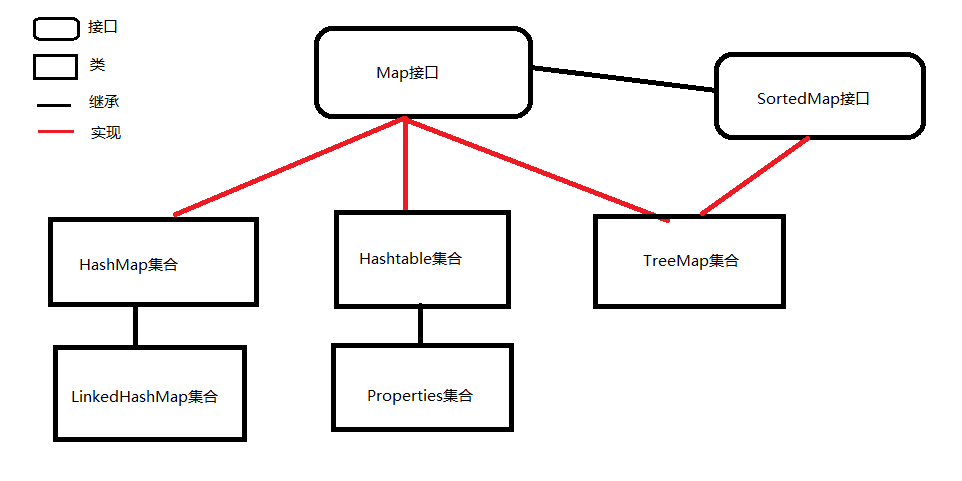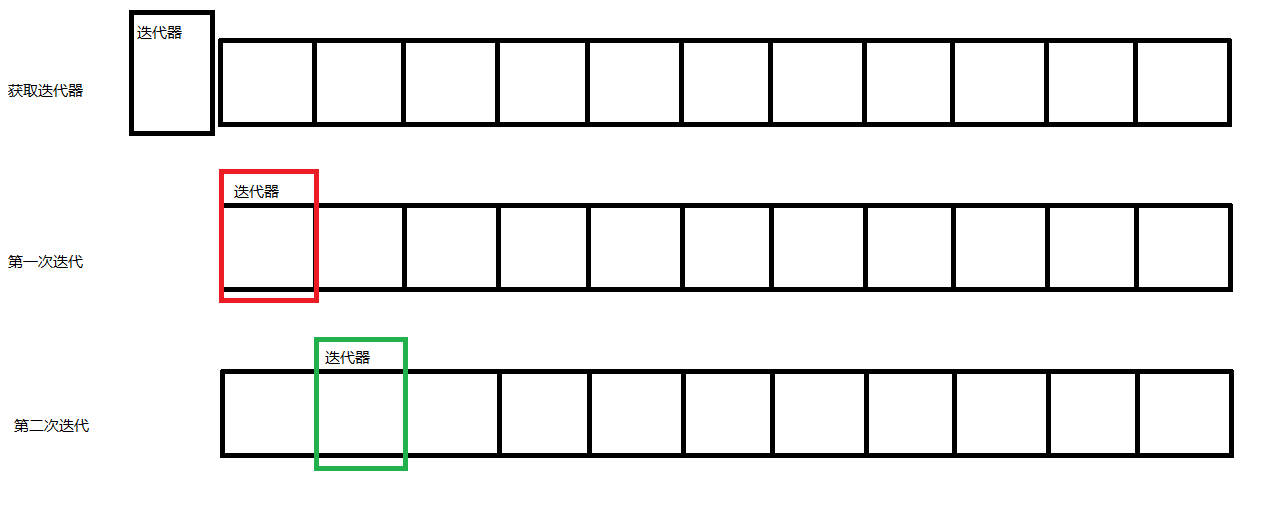集合
1.概念
1.1 集合的概念
1.2 集合的框架介绍
1.3 集合和数组的对比
2.Collection接口
2.1 Collection中常用的方法
3.泛型
3.1 什么是泛型
3.2 泛型的声明
3.3 说明
3.4 泛型使用时的注意事项
3.5 受限泛型
3.6 泛型应用在集合上
4.Iterator迭代器
4.1 迭代器的工作原理
4.2 迭代器的使用
5.List接口
5.1 List接口的存储特点
5.2 List接口的实现类
第一节 概念#
1.1 集合的概念
集合:就是一个存储数据的容器。
集合与数组一样,也是一个容器,与数组的区别:
1 数组长度固定,集合的长度不固定。
2 数组可以存储基本类型和引用类型,集合中存储的元素类型只能是引用类型。
1.2 集合的框架结构介绍
Collection集合的框架结构
Map集合的框架结构
1.3 集合与数组的对比
相同点:
都是数据的容器,在一个数组或集合中可以存储多个数据
不同点:
元素:数组中的元素只能是相同,集合中的元素是任意的
数组中可以存储基本类型和引用类型,集合只能存储引用类型
长度(元素个数):
数组是定长的,一旦初始化长度就不可以修改
集合长度可以修改,可以删除元素和添加元素
第二节 Collection接口#
Collection 层次结构 中的根接口。Collection 表示一组对象,这些对象也称为 collection 的元素。一些 collection 允许有重复的元素,而另一些则不允许。一些 collection 是有序的,而另一些则是无序的。
List派系:可以重复、有序
Set派系:不能重复、无序
2.1 Collection中常用的方法
| 方法名 | 描述 |
|---|---|
| add(E e) | 确保此 collection 包含指定的元素(可选操作)。 |
| addAll(Collection<? extends E> c) | 将指定 collection 中的所有元素都添加到此 collection 中(可选操作)。 |
| clear() | 移除此 collection 中的所有元素(可选操作)。 |
| contains(Object o) | 如果此 collection 包含指定的元素,则返回true。 |
| containsAll(Collection<?> c) | 如果此 collection 包含指定 collection 中的所有元素,则返回 true。 |
| equals(Object o) | 比较此 collection 与指定对象是否相等。 |
| isEmpty() | 如果此 collection 不包含元素,则返回true。 |
| iterator() | 返回在此 collection 的元素上进行迭代的迭代器。 |
| remove(Object o) | 从此 collection 中移除指定元素的单个实例,如果存在的话(可选操作)。 |
| removeAll(Collection<?> c) | 移除此 collection 中那些也包含在指定 collection 中的所有元素(可选操作)。 |
| retainAll(Collection<?> c) | 仅保留此 collection 中那些也包含在指定 collection 的元素(可选操作)。 |
| size() | 返回此 collection 中的元素数。 |
| toArray() | 返回包含此 collection 中所有元素的数组。 |
//1创建Collection对象
Collection collection=new ArrayList();
//2操作
//2.1添加
collection.add("张三");
collection.add("李四");
collection.add("他二大爷");
collection.add("他老爷");
collection.add("七大妈");
collection.add("张三");
System.out.println("集合的元素个数:"+collection.size());
//2.2删除
//2.2.1删除一个
// collection.remove("张三");
// System.out.println("删除之后的数据个数:"+collection.size());
//2.2.2清空
// collection.clear();
// System.out.println("清空之后:"+collection.size());
//3遍历
//3.1 使用增强for
System.out.println("--------使用增强for遍历----------");
for(Object obj:collection){
System.out.println(obj);
}
//3.2使用迭代器
System.out.println("-------使用迭代器---------");
Iterator it=collection.iterator();
while(it.hasNext()){
Object obj=it.next();
System.out.println(obj);
}
//4判断
//4.1判断是否存在
boolean b=collection.contains("王五");
boolean b2=collection.contains("他老爷");
System.out.println(b);
System.out.println(b2);
//4.2判断是否为空
System.out.println(collection.isEmpty());
//5查找
//6其他方法
Collection c1=new ArrayList();
c1.add("中国");
c1.add("朝鲜");
Collection c2=new ArrayList();
c2.add("中国");
c2.add("朝鲜");
System.out.println("c1.equals(c2):"+c1.equals(c2));
System.out.println("c1==c2:"+(c1==c2));
Collection collection=new ArrayList();
//1添加
collection.add(111);//111自动装箱 new Integer(111)
collection.add(222);
collection.add("111");
collection.add("222");
//2删除
System.out.println("元素的个数:"+collection.size());
System.out.println("删除之前:"+collection);
collection.remove("111");
System.out.println("删除之后:"+collection.size());
System.out.println("删除之后:"+collection);
//3遍历
//3.1增强for循环
System.out.println("增强for.....");
for (Object object : collection) {
System.out.println(object);
}
//3.2使用迭代器
System.out.println("迭代器.....");
Iterator it=collection.iterator();
while(it.hasNext()){
Object obj=it.next();
System.out.println(obj);
}
第三节 泛型#
3.1 什么是泛型
泛型就是可以表示一个广泛数据类型的类型参数(泛型只能表示引用类型),把数据类型作为参数来传递。
形式参数:声明方法时,在方法的参数列表中声明,而且在方法体中会使用到,是一个未知的数据。
实际参数:调用方法时,实际传递的参数。
类型参数:在一个类中声明一个未知的数据类型,在类中可以使用这个类型,但是具体类型取决于实例化时传入的实际类型。
3.2 泛型的声明
1)泛型可以声明在类中:(泛型类)
注意:
1 <E>:<>表示泛型,E(Element)表示占位符代替一个数据类型 ,其他的名称T(Type) V(Value) K(Key)
2 可以写多个泛型参数,如果写多个中间用逗号隔开
public class 类名<标识符>{
//类体
//泛型可以在类中充当成员变量
//泛型可以再类中充当方法的返回值
//泛型可以在类中充当方法的参数
}
2)泛型可以声明在方法中:(泛型方法)
public static <标识符> void fun(){}
3)泛型可以声明在接口中:(泛型接口)
public interface 接口名<标识符>{
//泛型可以充当接口中方法的返回值
//泛型可以充当接口中方法的参数
}
案例1:
/**
* 泛型类:泛型可以声明在类中
* @author wgy
* <>:表示泛型
* T(Type): 标识符 ,就是一个数据类型的占位符 E T V K
* 泛型参数可以写多个,中间用逗号隔开
*
* 泛型好处:
* (1)提高代码的重用性
* (2)防止类型转换异常,提高代码的安全性
*
*/
public class Generic<T> {
//1 使用泛型创建成员变量
T t;
//2 使用泛型作为方法的参数类型
public void show(T t) {
System.out.println(t);
}
//3使用泛型作为方法的返回值类型
public T getT() {
return t;
}
}
案例2:
/**
* 学生类
* @author wgy
*
*/
public class Student {
String name;
int age;
public void show(String s) {
System.out.println("姓名:"+name+" 年龄:"+age+" "+s);
}
/**
* 泛型方法
* T 占位符 表示一种未知的数据类型
* T type
* E
* K
* V
*/
public <T> void fun(T t) {
System.out.println(t);
}
}
案例3:
/**
* 接口
* 泛型的
* @author wgy
*
*/
public interface MyCollection<T> {
void add(T t);
void remove(T t);
T get();
}
public class MyArray<T> implements MyCollection<T>{
@Override
public void add(T t) {
// TODO Auto-generated method stub
System.out.println("添加了:"+t);
}
@Override
public void remove(T t) {
// TODO Auto-generated method stub
System.out.println("删除了:"+t);
}
@Override
public T get() {
// TODO Auto-generated method stub
return null;
}
}
案例4
import java.util.ArrayList;
import java.util.Collection;
import java.util.Iterator;
import javax.net.ssl.SSLContext;
public class Demo1 {
public static void main(String[] args) {
//创建泛型对象 元素类型String
Collection<String> coll=new ArrayList<String>();
//1添加
coll.add("苹果");
coll.add("桔子");
coll.add("芒果");
coll.add("西瓜");
System.out.println("元素个数:"+coll.size());
System.out.println(coll);
//2删除
// coll.remove("苹果");
// System.out.println("删除之后");
// System.out.println(coll);
//3遍历
//3.1增强for
System.out.println("---------增强for--------");
for(String s:coll) {
System.out.println(s);
}
System.out.println("---------迭代器--------");
Iterator<String> it=coll.iterator();
while(it.hasNext()) {
System.out.println(it.next());
}
}
}
3.3 说明
1)标识符(占位符):只要是一个合法的标识符即可,一般情况下,只使用一个大写字母表示泛型
例:public class Person<T>{} E(Element) K(key) V(value)
2)泛型的类型与声明的类或接口不需要有任何的关系
3)泛型可以在类中充当任何的成员
4)泛型具体类型取决于实例化对象时传入的实际类型
3.4 泛型使用时的注意事项
1)泛型不能在类中声明静态属性、常量
final修饰的属性必须在声明的同时初始化,所以泛型不能声明常量。
static修饰的属性是静态属性,先于对象,泛型类型取决于创建对象时传入的实际类型,所以泛型不能声明静态属性
综上所述:不能使用泛型声明静态属性、常量
2)泛型不能在类中初始化数组,但是可以声明数组
初始化数组时需要给元素进行分配空间,但是泛型类型不确定无法分配空间
3)在类中不能使用泛型声明参数个数相同的重载方法
当一个类中有两个泛型时,创建对象时,两个泛型使用相同类型替换,那么重载方法就是相同的方法(同名,参数列表也相同)
4)使用不同实际类型创建出的泛型类对象的引用不可以相互赋值。
3.5 受限泛型(理解即可)
1)<?>:表示任意类型
2)<? extends T>:表示T类或者T类的子类
3)<? super T>:表示T类或者T类的父类
3.6 泛型应用在集合上
泛型在集合中应用,表示的是集合中元素的类型
第四节 Iterator迭代器#
4.1 迭代器的工作原理
迭代器相当于一个游标,最初获取迭代器时,迭代器的位置在所有元素的前面,每迭代一个元素,迭代器向后移动一个位置
4.2 迭代器的使用
| 方法名 | 描述 |
|---|---|
| hasNext() | 判断迭代器是否存在下一个元素可以迭代器 |
| next() | 迭代器迭代下一个元素 |
| remove() | 从迭代器指向的 collection 中移除迭代器返回的最后一个元素(可选操作)。 |
第五节 List接口#
| 方法名 | 描述 |
|---|---|
| add(int index, E element) | 在列表的指定位置插入指定元素(可选操作)。 |
| addAll(int index, Collection<? extends E> c) | 将指定 collection 中的所有元素都插入到列表中的指定位置(可选操作)。 |
| containsAll(Collection<?> c) | 如果列表包含指定 collection 的所有元素,则返回true。 |
| get(int index) | 返回列表中指定位置的元素。 |
| indexOf(Object o) | 返回此列表中第一次出现的指定元素的索引;如果此列表不包含该元素,则返回 -1。 |
| lastIndexOf(Object o) | 返回此列表中最后出现的指定元素的索引;如果列表不包含此元素,则返回 -1。 |
| listIterator() | 返回此列表元素的列表迭代器(按适当顺序)。 |
| remove(int index) | 移除列表中指定位置的元素(可选操作)。 |
| set(int index, E element) | 用指定元素替换列表中指定位置的元素(可选操作)。 |
| subList(int fromIndex, int toIndex) | 返回列表中指定的 fromIndex(包括 )和 toIndex(不包括)之间的部分视图。 |
5.1 List接口的存储特点
1 相对有序存储,可以存储相同元素(不排重),可以通过下标访问集合元素
2 List接口中可以使用独有的迭代器ListIterator,具有反向遍历的功能
5.2 List接口的实现类
5.2.1 ArrayList类
ArrayList类是List接口的大小可变数组的实现。实现了所有可选列表操作,并允许包括null在内的所有元素。
存储特点:
相对有序存储,可以存储相同元素(不排重),可以通过下标访问集合元素,通过数组实现的集合
存储结构:数组
代码实现:
public class ArrayListDemo {
public static void main(String[] args) {
//创建一个ArrayList集合
ArrayList<String> list = new ArrayList<>();//构造方法中的泛型可以省略
list.add("zhangsan");//向集合中添加元素
list.add("lisi");
list.add("wangwu");
System.out.println(list.isEmpty());//判断list集合是否为空集合
System.out.println(list.size());//查看集合中元素的个数
System.out.println(list.get(1));//获取集合中下标为1的元素
System.out.println(list.set(1,"zhaoliu"));//修改集合中下标为1的元素
System.out.println(list.contains("wangwu"));//查看"wangwu"是否是集合中的元素
list.remove("wangwu");//删除集合中"wangwu"元素
list.remove(1);//删除集合中下标为1的元素
//for循环遍历集合
for(int i=0; i<list.size(); i++){
System.out.println(list.get(i));
}
//使用Iterator迭代器遍历
Iterator<String> it = list.iterator();//获取迭代器
while(it.hasNext()){
System.out.println(it.next());
}
//使用ListIterator迭代器遍历
ListIterator<String> lit = list.listIterator();
while(lit.hasNext()){
System.out.println(lit.next());
}
//反向遍历
while(lit.hasPrevious()){
System.out.println(lit.previous());
}
}
}
5.2.2 LinkedList类
LinkedList类是List接口的链接列表实现。实现所有可选的列表操作,并且允许所有元素(包括null)。
存储结构:双向链表
存储特点:
相对有序存储,可以存储相同元素(不排重),可以通过下标访问集合元素,通过链表实现的集合
**
* LinkedList的使用
* 存储结构:链表
* @author wgy
*
*/
public class Demo5 {
public static void main(String[] args) {
//创建集合
LinkedList<String> linkedList=new LinkedList<>();
//1添加元素
linkedList.add("苹果");
linkedList.add("葡萄");
linkedList.add("西瓜");
linkedList.add("芒果");
linkedList.add("桃子");
System.out.println("元素个数:"+linkedList.size());
System.out.println("打印:"+linkedList.toString());
//2删除
// linkedList.remove(0);
// System.out.println("删除之后:"+linkedList.toString());
//3遍历
//3.1for
//3.2foreach
//3.3迭代器
System.out.println("-----------迭代器-----------");
Iterator<String> it = linkedList.iterator();
while(it.hasNext()) {
System.out.println(it.next());
}
//3.4 列表迭代器
System.out.println("-----------列表迭代器-----------");
ListIterator<String> lit = linkedList.listIterator();
while(lit.hasNext()) {
System.out.println(lit.next());
}
//3.5降序迭代器
System.out.println("-----------降序迭代器-----------");
Iterator<String> dit = linkedList.descendingIterator();
while(dit.hasNext()) {
System.out.println(dit.next());
}
//4判断
System.out.println("isEmpty:"+linkedList.isEmpty());
System.out.println("苹果:"+linkedList.contains("苹果"));
//5查找位置
System.out.println("桃子的位置:"+linkedList.indexOf("桃子"));
}
}
ArrayList和LinkedList的总结
ArrayList存储结构是数组,LinkedList存储结构是双向链表。
ArrayList集合适用在对元素查询、遍历操作,不适合插入和删除。
LinkedList集合适用在对元素插入和删除操作,不适合遍历和查找。
5.2.3 Vector(了解)
Vector类可以实现可增长的对象数组。与数组一样,它包含可以使用整数索引进行访问的组件。但是Vector
的大小可以根据需要增大或缩小,以适应创建 Vector后进行添加或移除项的操作。
public static void main(String[] args) {
//创建集合
Vector<String> vector=new Vector<>();
//1添加元素
vector.add("xxx");
vector.add("yyy");
vector.add("zzz");
System.out.println(vector.toString());
//2删除
// vector.remove(0);
// System.out.println("删除之后:"+vector.toString());
//3遍历
//3.1for
//3.2foreach
//3.3迭代器
//3.4枚举器
Enumeration<String> elements = vector.elements();
while(elements.hasMoreElements()) {
System.out.println(elements.nextElement());
}
5.2.4 Stack(了解)
Stack类表示后进先出(LIFO)的对象栈。是Vector的子类。
public static void main(String[] args) {
//创建集合(先进后出,后进先出)
Stack<String> stack=new Stack<>();
//1入栈
stack.push("abc");
stack.push("hello");
stack.push("你好");
stack.push("他好");
stack.push("大家好");
//2出栈
System.out.println("---------出栈---------");
int size=stack.size();
for(int i=0;i<size;i++) {
String s=stack.pop();
System.out.println(s);
}
}
5.2.5 ArrayList与LinkedList,Vector三种实现类存储的比较
a.功能基本相同
b.底层存储结构:ArrayList是数组,LinkedList是链表,Vector是数组
c.Vector是一个古老的集合,从JDK1.0开始就有了,Vector存在一些方法名比较长的方法,xxxElement
d.Vector是线程安全的,效率低,ArrayList是线程不安全的,效率高,推荐使用ArrayList【Collections工具类中有相应的方法可以将ArrayList改为线程安全的】
e.ArrayList查找遍历比较快,LinkedList插入删除比较快
总结#
1 集合概念,用来存储一组数据的容器。和数组类似
数组是长度固定的,集合长度可以变化。
数组能存储基本类型和引用类型,集合只能存储引用类型。
2 Collection接口,父接口, add() remove() clear() contains() iterator()
3 Collection有两个子接口 List和Set
4 泛型:本质使用数据类型作为参数传递
4.1 定义泛型类 泛型方法 泛型接口
4.2 使用泛型类创建类对象,指定泛型的实际类型
4.3 泛型限制,<?> 表示任何类型
<? extends T> 表示泛型上限, T类型或T的子类
<? super T> 表示泛型下限,T类型或T的父类
5 Iterator迭代器
hasNext();
next();
remove(); //防止并发操作
6 List接口
List接口的特点:有序的,可以重复
7 ArrayList实现类
存储结构:数组
适合遍历查找
8 LinkedList实现
存储结构:双向链表
适合做添加,删除
9 Vector向量集合 Stack栈 (先进后出)







【推荐】还在用 ECharts 开发大屏?试试这款永久免费的开源 BI 工具!
【推荐】国内首个AI IDE,深度理解中文开发场景,立即下载体验Trae
【推荐】编程新体验,更懂你的AI,立即体验豆包MarsCode编程助手
【推荐】轻量又高性能的 SSH 工具 IShell:AI 加持,快人一步
· 软件产品开发中常见的10个问题及处理方法
· .NET 原生驾驭 AI 新基建实战系列:向量数据库的应用与畅想
· 从问题排查到源码分析:ActiveMQ消费端频繁日志刷屏的秘密
· 一次Java后端服务间歇性响应慢的问题排查记录
· dotnet 源代码生成器分析器入门
· ThreeJs-16智慧城市项目(重磅以及未来发展ai)
· .NET 原生驾驭 AI 新基建实战系列(一):向量数据库的应用与畅想
· Browser-use 详细介绍&使用文档
· 软件产品开发中常见的10个问题及处理方法
· Vite CVE-2025-30208 安全漏洞